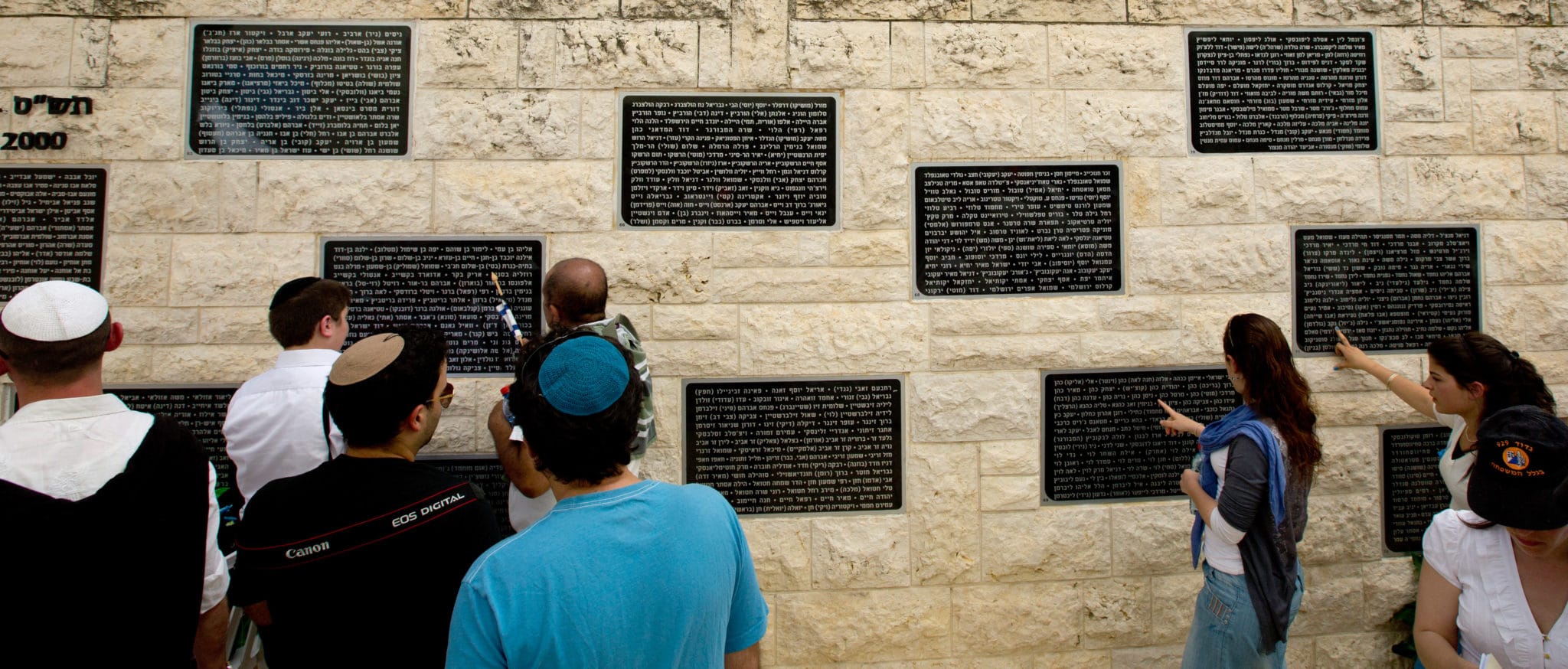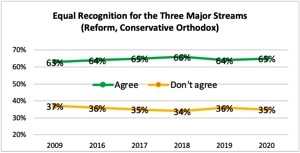 JERUSALEM, ISRAEL – APRIL 15: Family members of ‘victims of ‘terror’during the Second Intifada years in the early 2000s point to their loved ones’ names on plaques on the ‘Victims Of Terror’ memorial wall as a Memorial Ceremony is held during Remembrance Day for the fallen soldiers at Mount Herzel Military Cemetery on April 15, 2013 in Jerusalem, Israel. On Remembrance Day Isrealis remember more than 25,000 men and women who have been killed in combat or conflict since 1860. In accordance with the Jewish calendar, the day is followed by the anniversary of the creation of Israel. (Photo by Jim Hollander – Pool/Getty Images)
JERUSALEM, ISRAEL – APRIL 15: Family members of ‘victims of ‘terror’during the Second Intifada years in the early 2000s point to their loved ones’ names on plaques on the ‘Victims Of Terror’ memorial wall as a Memorial Ceremony is held during Remembrance Day for the fallen soldiers at Mount Herzel Military Cemetery on April 15, 2013 in Jerusalem, Israel. On Remembrance Day Isrealis remember more than 25,000 men and women who have been killed in combat or conflict since 1860. In accordance with the Jewish calendar, the day is followed by the anniversary of the creation of Israel. (Photo by Jim Hollander – Pool/Getty Images) If you can’t remember where you were when the Second Intifada started, it’s not surprising. Unlike most wars (the Yom Kippur War, for example) and unlike most terror events (such as 9/11), the Second Intifada didn’t start on a specific date. When it started, it was not yet an intifada, only scattered violent incidents and demonstrations. No one knew at the time that these alarming incidents were going to continue for years and alter the Israeli-Palestinian conflict, and with it, the Middle East.
While there was no specific date, the Second Intifada began somewhere between the end of September and the beginning of October 2000. On Sept. 28, the then head of the opposition, Ariel Sharon, visited the Temple Mount amid a violent protest. The following day, Palestinians rioted and a few were killed by police fire. An Israeli officer was killed by a fellow Palestinian officer. Two days later, a French TV station aired video footage of a Gazan boy, Muhammad al-Durrah, killed when he was caught in the crossfire between Israelis and Palestinians, which spurred even more anger and violence.
The circumstances surrounding al-Durrah’s death are still being debated. Israel was blamed for the shooting and apologized. But it’s far from clear that he was killed by Israeli gunfire.
On Oct. 1, 2000, Palestinians raided Joseph’s Tomb in Nablus in the West Bank and shot an Israeli soldier. The soldier was supposed to have been evacuated by Palestinian Authority (PA) forces, but he was left to die. Much like al-Durrah, the abandoned soldier, Madhat Yusuf, became a household name, signaling the end of the period during which Israel still trusted the Palestinians’ good intentions. After Yusuf’s death, security ties between the Israel Defense Forces and the PA crumbled. A friend became a foe.
The Second Intifada doesn’t have an official day of observance. It was a long slog, with thousands of deaths; tens of thousands of incidents and attacks, large and small; hundreds of attempts to change policies; and dozens of debates about cause and effect. Suicide bombers became the symbol of its horrors. When the Second Intifada died down — again, there was no specific end date — the corpse of the peace process was revealed, bruised and mutilated. It was buried without fanfare or dignity. The stench of death erased the smell of White House Rose Garden peace ceremonies.
Young soldiers today can’t remember these consequential events. For them, the Second Intifada isn’t much different than the Six-Day War or the first Lebanon war: material for study and history, not one of personal meaning. Older Israelis, like me, still shudder at the thought of raising these young soldiers as young children in those cursed years of terror.
Since the Second Intifada, many Israelis no longer see peace with the Palestinians as a realistic goal.
There are still enough of us around to remember some of the lessons we learned back then: we live in a dangerous neighborhood; we can’t trust anyone except ourselves; a disappointing peace process is worse than no peace process; festive speeches are no match for a suicide bomber; cold equilibrium is better than illusory progress.
Since the Second Intifada, many Israelis no longer believe in the peace process as it was designed in the 1990s. Many no longer see peace with the Palestinians as a realistic goal. Many wouldn’t even consider an arrangement that compromises on their future security. And sadly, many of them lost interest in the plight of the Palestinians. Many lost their ability to sympathize with the Palestinians. It isn’t easy to empathize with someone who has tried to kill you, your children and your parents, who rejoiced when your friends, relatives or neighbors were killed.
But isn’t making peace something you do with enemies? It is. And it was attempted in the 1990s, but we were deceived. At least, that’s the story as most Israelis understand it. That’s the narrative that directs their behavior. And if Palestinians have a different story to tell about the Second Intifada, we can’t hear it — because our ears are still ringing from the blast of the bombs in the center of our cities.
After 20 years, you might expect hindsight. But there is none. We live the hindsight. Our policies are the hindsight. Our realities are the hindsight. Where were we all when the Second Intifada started? We were here, learning lessons.
Rosner online
The latest edition of the Sunday Israel File explained the political dynamics of recent weeks:
The right bloc is getting stronger, even though right-wing Likud is getting weaker, thanks to the rise of right-wing Yamina. Yamina’s leader, Naftali Bennett, is focusing on the fight against the coronavirus and is seen as an adult in a field of juveniles. Bennett attracts voters from Likud, but also from Blue and White and other parties.
A week’s numbers
The survey “2020 Israel Religion & State Index” conducted by the organization Hiddush for “Freedom of Religion for Israel” reveals some things barely change:

Insight: After 10 years, it’s clear that passive public support isn’t the issue. The streams that fight for recognition need active support.
A reader’s response
I wrote that Rep. Alexandria Ocasio-Cortez’s (D-N.Y.) decision to withdraw from a memorial event for the late Prime Minister Yitzhak Rabin “is not a disappointment. It is a wake-up call.”
Shany Mor tweeted: “The big story is neither AOC nor BDS. The big failure here is APN’s and the kind of politics that this organization, along with J Street, runs. APN brought on this mess and it highlights their perceptual failure when it comes to American (and Israeli) politics.”
My response: Because I agree with Mor, I’ll just clarify the abbreviations: AOC = Alexandria Ocasio-Cortez; BDS = boycott, divestment and sanctions; APN=Americans for Peace Now (the organization that invited and was shunned by AOC).
Shmuel Rosner is senior political editor. For more analysis of Israeli and international politics, visit jewishjournal.com/rosnersdomain.























 More news and opinions than at a Shabbat dinner, right in your inbox.
More news and opinions than at a Shabbat dinner, right in your inbox.